When manufacturing stainless steel water bottles, you'll encounter challenges like sourcing top-grade stainless steel for durability. Balancing functional design with aesthetics and meeting strict industry standards are crucial hurdles. Efficient production to manage costs, adapt to raw material price fluctuations, and fulfill consumer preferences are ongoing battles. Overcoming distribution and shipping complexities is key for successful operations. This brief overview provides insights into the common obstacles stainless steel water bottle manufacturers face.
Sourcing High-Quality Stainless Steel
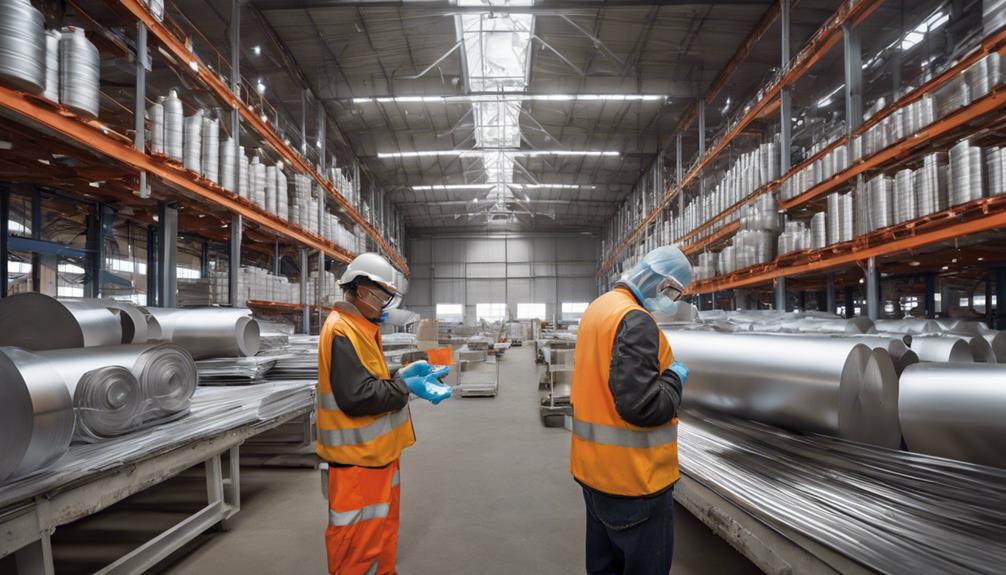
To ensure optimal durability and safety standards, stainless steel water bottle manufacturers must carefully select suppliers renowned for consistently providing high-quality stainless steel. Stainless steel sourcing challenges often arise due to the need for stringent quality assurance measures in material selection.
Manufacturers face the crucial task of sourcing stainless steel that meets specific requirements for strength, corrosion resistance, and overall product safety. This necessitates close collaboration with suppliers to ensure that the material used meets industry standards and regulatory requirements.
Quality assurance plays a pivotal role in the sourcing process, as any compromise in material quality can have significant implications for the final product. By prioritizing material selection based on quality standards, manufacturers can enhance production efficiency and mitigate potential risks associated with substandard materials.
This proactive approach not only safeguards product integrity but also contributes to overall manufacturing excellence. Ultimately, sourcing high-quality stainless steel is a foundational step in ensuring the production of durable and safe stainless steel water bottles.
Designing for Functionality and Aesthetics
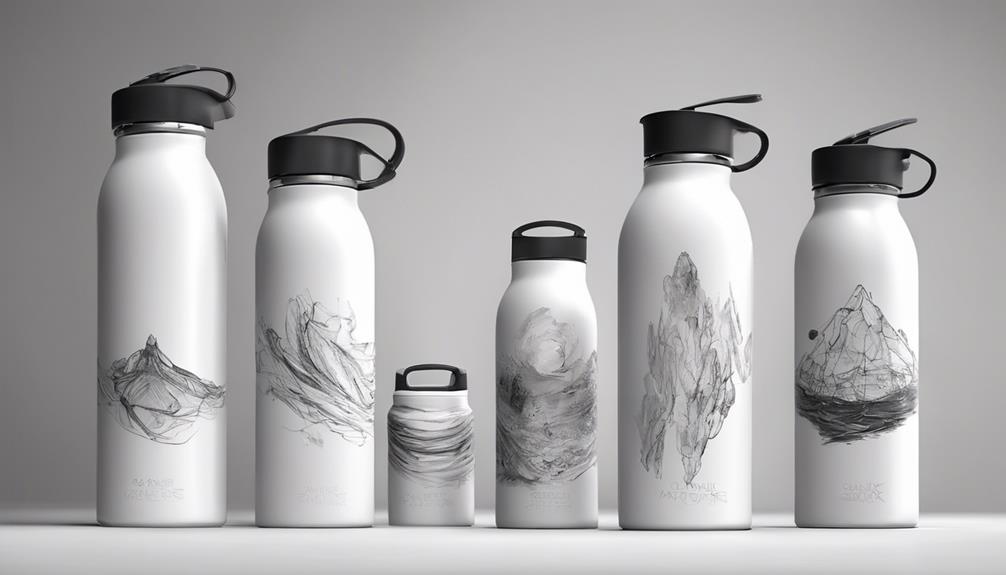
When designing stainless steel water bottles, you must carefully consider dual-purpose functionality to meet consumer needs efficiently.
Balancing form and function is essential to create a product that appeals visually while ensuring practical usability.
Striking the right balance between aesthetics and functionality is paramount for manufacturers in this competitive market.
Dual-Purpose Design Considerations
Designing stainless steel water bottles to seamlessly balance both functionality and aesthetics presents a crucial challenge for manufacturers in the industry. When considering dual-purpose design, incorporating eco-friendly features like BPA-free materials and recyclability is vital to align with current market trends.
Product customization plays a crucial role in appealing to a wide range of consumers and can be a key component of marketing strategies.
Manufacturers must carefully consider the practical aspects of the water bottle design, such as leak-proof seals, easy-to-clean surfaces, and ergonomic shapes that enhance user experience. These functional elements shouldn't compromise the visual appeal of the product.
Striking the right balance between functionality and aesthetics requires meticulous attention to detail and innovative design solutions.
Additionally, keeping abreast of market trends and consumer preferences is essential for creating stainless steel water bottles that stand out in a competitive market. By integrating eco-friendly features, offering customizable options, and maintaining a harmonious blend of form and function, manufacturers can meet the dual-purpose design challenge effectively.
Balancing Form and Function
Achieving a harmonious blend of functionality and aesthetics is a critical endeavor for stainless steel water bottle manufacturers. Design trends play a crucial role in ensuring that the bottles not only serve their purpose effectively but also appeal to consumers visually. By incorporating modern design trends, such as minimalist or eco-friendly styles, manufacturers can attract a wider audience.
Manufacturing techniques also play a significant role in balancing form and function. Innovations in production processes allow for intricate designs without compromising the durability and usability of the water bottles. By leveraging advanced manufacturing techniques like laser welding or hydroforming, manufacturers can create bottles that are both visually appealing and structurally sound.
User experience is another key aspect to consider when designing stainless steel water bottles. Conducting thorough product testing to evaluate ease of use, leak-proof features, and overall performance is essential in ensuring that the bottles meet consumers' expectations. By prioritizing user experience during the design process, manufacturers can create products that excel in both functionality and aesthetics.
Ensuring Product Durability and Longevity
To ensure the durability and longevity of stainless steel water bottles, manufacturers must prioritize selecting high-quality materials and implementing rigorous quality control measures throughout the production process. This involves:
- Material Selection: Opt for premium grade stainless steel with corrosion-resistant properties and high tensile strength to withstand daily use and potential impacts.
- Quality Control: Implement strict quality checks at every stage of manufacturing, from initial shaping to final finishing, to identify and rectify any defects promptly.
- Testing Procedures: Conduct comprehensive tests such as pressure resistance, leak checks, and durability assessments to guarantee that each bottle meets stringent performance standards.
Meeting Strict Industry Standards and Regulations
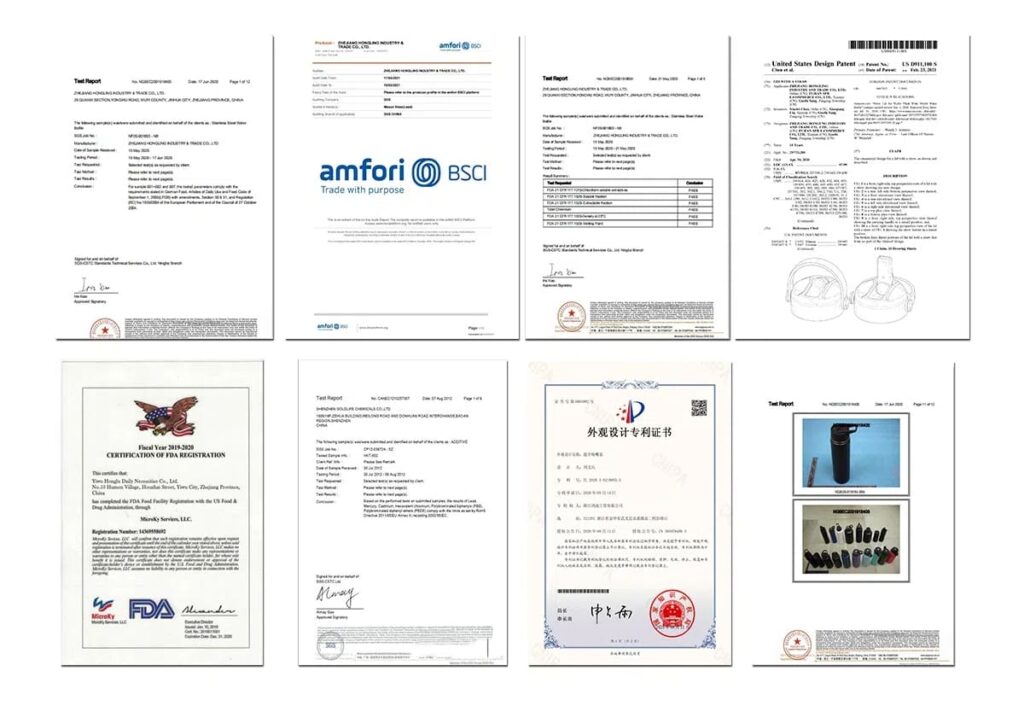
You must navigate through regulatory compliance challenges, adhere to stringent quality control standards, and meet certification requirements to ensure your stainless steel water bottles meet industry standards.
Ensuring that your manufacturing processes and materials meet these regulations is crucial for the safety and quality of your products.
Regulatory Compliance Challenges
Meeting the strict industry standards and regulations poses significant challenges for manufacturers of stainless steel water bottles. Ensuring compliance documentation throughout the supply chain is crucial to meet regulatory audits and safety standards.
Here are three key regulatory compliance challenges faced by manufacturers:
- Complex Regulations: Navigating through the intricate web of regulations set by different authorities can be daunting. From FDA regulations to environmental standards, ensuring adherence to each requirement demands meticulous attention to detail.
- Changing Standards: Regulatory standards are dynamic and subject to frequent updates. Manufacturers must stay abreast of these changes to ensure their products comply with the latest safety regulations. Failure to do so can result in costly production delays or even non-compliance penalties.
- Global Compliance: Operating in a global market means manufacturers must comply with a variety of international regulations. Understanding and aligning with diverse regulatory frameworks add layers of complexity to the compliance process, requiring a comprehensive approach to meet all necessary standards across different regions.
Quality Control Standards
Navigating through the ever-evolving landscape of quality control standards in the stainless steel water bottle manufacturing industry presents a formidable challenge for manufacturers. Ensuring adherence to stringent quality control standards is crucial in maintaining product integrity and consumer satisfaction.
Manufacturing processes play a pivotal role in determining the quality of stainless steel water bottles. From material sourcing to fabrication techniques, each step must meet specified standards to guarantee the durability and safety of the final product. Implementing robust quality control measures throughout the manufacturing process is essential to identify and rectify any deviations promptly.
Product testing is another key aspect of maintaining quality control standards. Conducting thorough tests for leak resistance, durability, and material safety is imperative to validate the performance and reliability of stainless steel water bottles. Manufacturers must invest in advanced testing equipment and methodologies to uphold the highest quality standards and comply with industry regulations.
Certification Requirements
Ensuring compliance with stringent industry standards and regulations is paramount for stainless steel water bottle manufacturers seeking certification. Meeting these certification requirements involves a meticulous approach to production efficiency and cost-effectiveness.
Here are key considerations to help navigate the certification process:
- Production Efficiency:
Streamlining manufacturing processes is essential to meet certification standards. Implementing efficient production methods not only ensures compliance but also improves overall operational effectiveness.
- Cost Effectiveness:
Balancing quality and cost is crucial when aiming for certification. Manufacturers must find innovative ways to reduce production costs without compromising the integrity of the product.
- Marketing Strategies and Brand Positioning:
Obtaining certifications can significantly enhance a brand's reputation and marketability. Leveraging certifications in marketing strategies can strengthen brand positioning, instill consumer confidence, and open doors to new market opportunities. Manufacturers should capitalize on certifications to differentiate themselves from competitors and build a loyal customer base.
Managing Production Costs Effectively
Effectively managing production costs is crucial for stainless steel water bottle manufacturers to ensure profitability and competitiveness in the market. To stay ahead in the industry, implementing cost-cutting strategies and enhancing production efficiency are imperative. By optimizing manufacturing processes, streamlining operations, and minimizing waste, you can effectively reduce expenses while maintaining product quality.
Additionally, pricing strategies play a significant role in navigating market competition. Conducting thorough market research to understand consumer demands and competitors' pricing structures enables you to set competitive prices without compromising your profit margins.
Implementing dynamic pricing strategies that consider market fluctuations and demand trends can help you stay agile and responsive in a competitive market environment.
Addressing Environmental Sustainability Concerns
To enhance the environmental sustainability of stainless steel water bottle manufacturing, consider adopting eco-friendly materials and energy-efficient production processes. Incorporating these practices can significantly reduce your carbon footprint and contribute to a greener future.
Here are key strategies to address environmental concerns:
- Eco-Friendly Manufacturing: Utilize materials that are renewable, recyclable, and have minimal environmental impact. Opt for stainless steel made from recycled content and water-based coatings to reduce harmful emissions.
- Sustainable Packaging: Implement packaging solutions that prioritize recyclability and biodegradability. Use minimalistic designs to reduce material waste and consider alternatives like compostable packaging materials.
- Recycling Initiatives: Establish a robust recycling program within your manufacturing facility to ensure that waste materials are properly sorted and recycled. Partner with recycling facilities to responsibly dispose of any production waste and encourage a circular economy approach.
Handling Supply Chain Logistics Efficiently
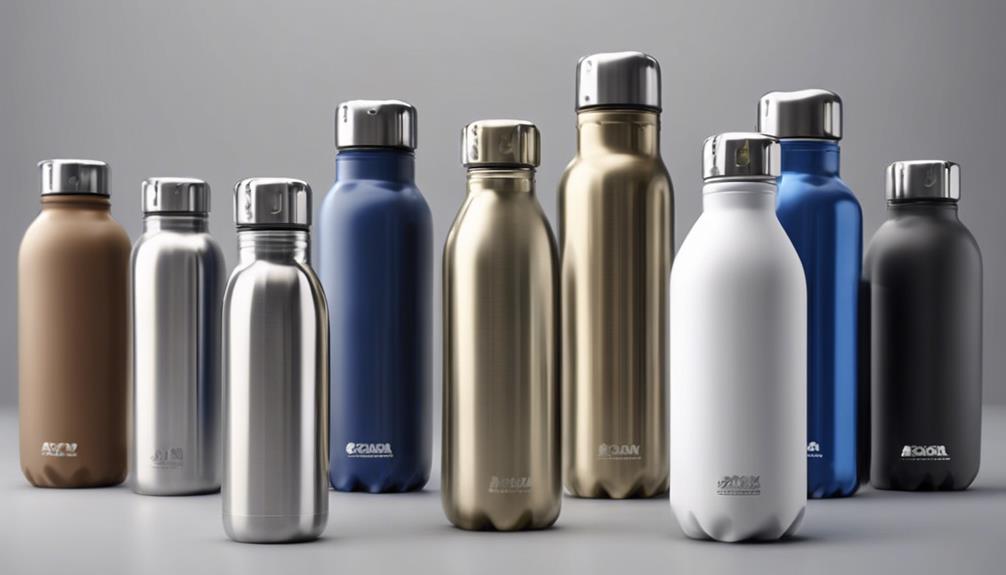
You must focus on efficient inventory management to minimize excess stock and prevent shortages.
By streamlining transportation processes, you can reduce lead times and enhance overall supply chain efficiency.
Implementing robust logistics strategies is crucial for optimizing the movement of materials and ensuring timely deliveries.
Efficient Inventory Management
Efficient inventory management plays a critical role in optimizing supply chain logistics for stainless steel water bottle manufacturers. To ensure smooth operations and meet customer demand, focus on the following key aspects:
- Supplier Relations and Production Scheduling:
Strengthening relationships with suppliers is essential for timely inventory replenishment. Establish clear communication channels and agreements to avoid disruptions. Effective production scheduling aligns manufacturing with demand forecasts, preventing overstocking or stockouts.
- Inventory Optimization and Demand Forecasting:
Implementing robust inventory optimization techniques helps in maintaining optimal stock levels. Utilize software tools and data analytics to track inventory turnover rates and identify slow-moving items. Accurate demand forecasting minimizes excess inventory by predicting future customer needs more precisely.
- Efficient Tracking Systems:
Invest in advanced tracking systems to monitor inventory levels in real-time. Barcode technology, RFID systems, or inventory management software can enhance visibility across the supply chain, enabling proactive decision-making and reducing the risk of stock imbalances.
Streamlining Transportation Processes
Strengthening transportation processes is fundamental for optimizing supply chain logistics in the stainless steel water bottle manufacturing industry. Efficient transportation plays a critical role in ensuring timely delivery of raw materials for production and shipping finished products to distributors or retailers. By streamlining transportation processes, manufacturers can minimize delays, reduce costs, and enhance overall operational efficiency within the supply chain.
To illustrate the importance of transportation optimization, consider the following table showcasing key aspects of supply chain logistics and packaging solutions:
| Aspect | Description | Impact |
|---|---|---|
| Route Optimization | Utilizing the most efficient routes | Cost savings |
| Inventory Tracking | Real-time monitoring of shipments | Improved accuracy |
| Carrier Selection | Choosing reliable and cost-effective carriers | Timely deliveries |
| Packaging Efficiency | Implementing eco-friendly packaging solutions | Sustainability |
| Last-Mile Delivery | Ensuring prompt delivery to end consumers | Customer satisfaction |
Dealing With Quality Control Issues
To ensure the production of high-quality stainless steel water bottles, manufacturers must implement rigorous quality control measures throughout the manufacturing process. When dealing with quality control issues, focus on improving inspection methods and implementing corrective actions to enhance product quality consistently.
Pay close attention to supplier quality to ensure that raw materials meet the required standards. Material consistency is crucial for producing durable and reliable stainless steel water bottles.
Here are key strategies to address quality control challenges:
- Enhance Inspection Methods: Regularly review and update inspection protocols to identify any deviations from quality standards promptly.
- Implement Corrective Actions: Develop a systematic approach to address issues identified during quality control checks, ensuring continuous improvement in product quality.
- Ensure Supplier Quality and Material Consistency: Collaborate closely with suppliers to maintain consistent material quality and specifications, preventing variations that could impact the final product.
Balancing Innovation and Tradition in Design
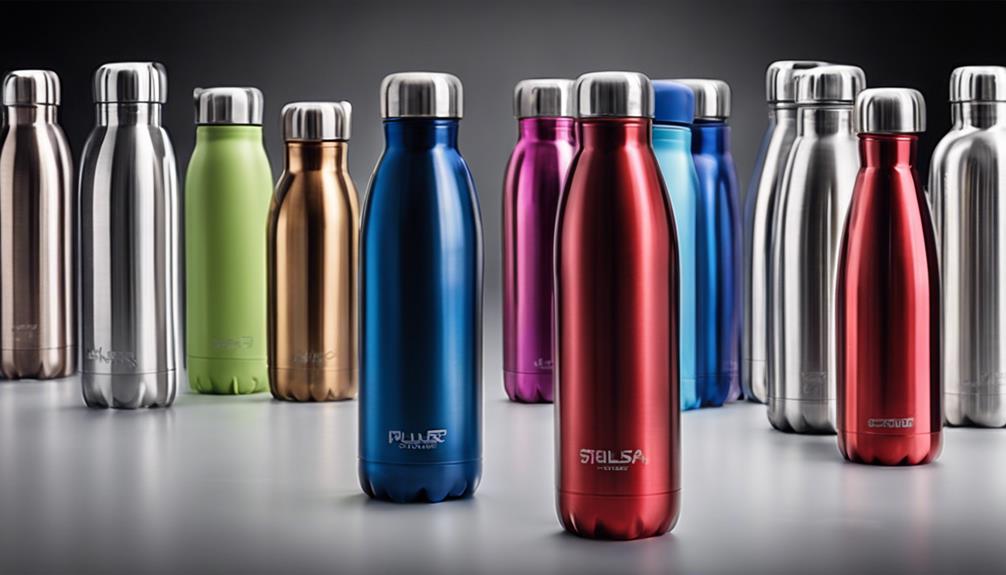
In designing stainless steel water bottles, striking a balance between innovation and tradition is essential to meet consumer demands while maintaining product quality standards. Innovation trends in stainless steel water bottle design are constantly evolving, pushing manufacturers to blend modern advancements with classic elements.
Design evolution plays a crucial role in attracting consumers who seek both functionality and aesthetic appeal in their water bottles.
To address this challenge, manufacturers must embrace innovative features such as advanced lid mechanisms, sleek ergonomic shapes, and customizable options while staying true to traditional aspects like durable stainless steel construction and reliable insulation properties.
By incorporating the latest innovation trends into their designs, manufacturers can cater to a wider range of consumer preferences while upholding the reputation of stainless steel water bottles for their reliability and sustainability.
Successfully balancing innovation and tradition in design not only sets manufacturers apart in a competitive market but also ensures that stainless steel water bottles remain a top choice for eco-conscious consumers seeking quality and style in their hydration products.
Competing With Other Materials in the Market

You must address the challenges of material market competition and industry material challenges when competing with other materials in the market.
Analyze the strengths and weaknesses of stainless steel against materials like plastic, glass, and aluminum to identify areas for improvement.
Implement strategies to highlight the unique selling points of stainless steel water bottles to stay competitive in the market.
Material Market Competition
Stainless steel water bottle manufacturers must navigate intense competition from a wide array of materials vying for market dominance. When facing material market competition, it's essential to understand how pricing strategies and marketing tactics can influence consumer trends and market demand.
Here are key points to consider:
- Material Durability: Stainless steel offers superior durability compared to many other materials in the market. Highlighting this strength through marketing campaigns can attract consumers looking for long-lasting water bottles.
- Eco-friendliness: With the growing emphasis on sustainability, materials like stainless steel are favored for their recyclability and reduction of single-use plastic. Capitalizing on this consumer trend can give stainless steel bottles a competitive edge.
- Design Flexibility: Materials like plastic and glass may offer more design flexibility than stainless steel. To compete effectively, manufacturers must innovate with design while maintaining the durability and eco-friendly aspects that consumers value in stainless steel bottles.
Industry Material Challenges
Facing stiff competition from materials like plastic and glass, stainless steel water bottle manufacturers encounter significant challenges in establishing their products as the preferred choice in the market. The versatility of plastic and the aesthetic appeal of glass pose formidable obstacles to stainless steel's market dominance.
To overcome these hurdles, manufacturers must leverage advanced manufacturing techniques to enhance the durability, design, and functionality of stainless steel bottles. Keeping abreast of market trends is crucial for identifying consumer preferences and adapting production processes accordingly.
Moreover, offering product customization options can be a key differentiator in attracting customers who seek personalized solutions. By forming strategic industry partnerships with suppliers and distributors, manufacturers can streamline production processes, reduce costs, and expand their market reach.
Collaborations with other businesses can also provide access to innovative technologies and materials, giving stainless steel water bottle manufacturers a competitive edge in the industry. Ultimately, by focusing on continuous improvement and innovation, stainless steel bottle producers can carve out a distinct niche in the market amidst strong material competition.
Navigating Fluctuating Raw Material Prices
When navigating fluctuating raw material prices, stainless steel water bottle manufacturers must carefully monitor market trends and adapt their sourcing strategies accordingly.
The following points are crucial for effectively managing price fluctuations:
- Market Trends Analysis: Stay informed about market trends and anticipate potential price changes in raw materials to proactively adjust your sourcing strategies. Utilize industry reports and data analytics tools to make informed decisions.
- Diversification of Suppliers: Building a robust supply chain with multiple reliable suppliers can help mitigate risks associated with sudden price hikes. By having alternative sources for raw materials, you can negotiate better prices and ensure a steady supply.
- Long-Term Contracts: Consider entering into long-term contracts with suppliers to secure stable prices for raw materials over an extended period. While this may involve some commitment, it can provide stability and predictability in pricing, protecting your manufacturing costs from unexpected spikes.
Adapting to Changing Consumer Preferences
To effectively adapt to changing consumer preferences, stainless steel water bottle manufacturers must conduct thorough market research and analyze shifting trends. Consumer preferences are increasingly leaning towards eco-friendly materials and customization options in stainless steel water bottles.
Incorporating eco-friendly materials such as BPA-free plastics or recyclable stainless steel can attract environmentally conscious consumers. Offering customization options like personalized engravings, color choices, or interchangeable lids can cater to individuals seeking unique and personalized products.
By staying abreast of consumer demands for sustainable materials and personalized products, manufacturers can meet the evolving needs of the market. Utilizing eco-friendly materials not only aligns with current consumer values but also demonstrates a commitment to sustainability.
Providing customization options allows consumers to feel a sense of ownership over their products, leading to increased brand loyalty and customer satisfaction.
Overcoming Distribution and Shipping Challenges
Manufacturers of stainless steel water bottles must strategize to navigate the complexities of distribution and shipping challenges efficiently. When facing shipping delays and distribution challenges, consider the following:
- Implement Efficient Packaging Solutions:
Opt for packaging that ensures the protection of stainless steel water bottles during transit while also maximizing space efficiency to reduce shipping costs.
- Enhance Transportation Efficiency:
Utilize advanced logistics technology to optimize routes, minimize handling time, and coordinate deliveries effectively, reducing the risk of delays and ensuring timely shipments.
- Collaborate with Reliable Shipping Partners:
Establish partnerships with reputable shipping companies known for their reliability and ability to handle the specific requirements of transporting stainless steel water bottles safely and promptly.
Building Brand Reputation and Trust
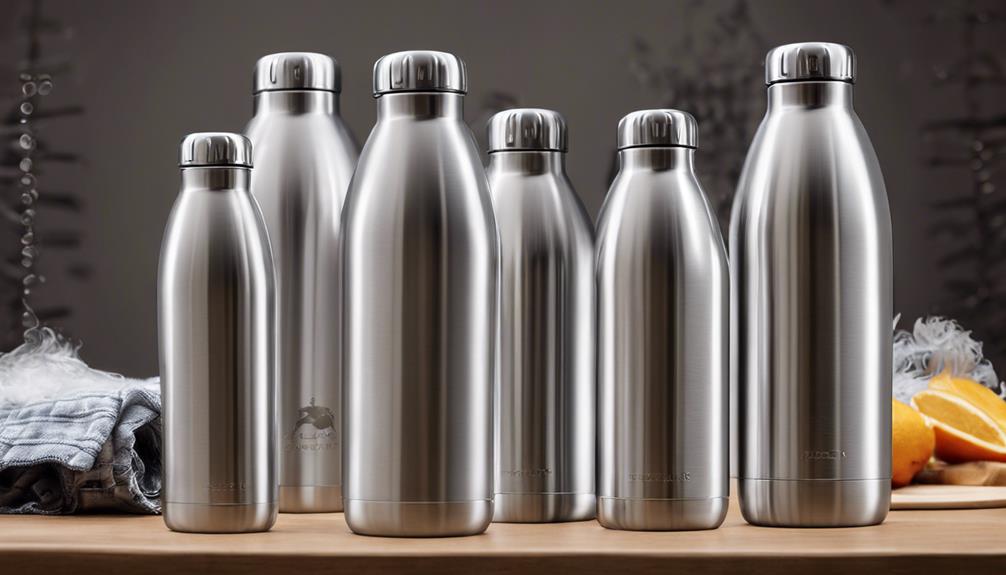
Establishing a strong brand reputation and fostering trust are pivotal for stainless steel water bottle manufacturers seeking to differentiate themselves in a competitive market. Customer satisfaction and brand loyalty are directly linked to how well a company builds and maintains its reputation.
To achieve this, leveraging social media platforms is crucial. Engaging with customers through social media not only boosts brand visibility but also allows for direct interaction, addressing concerns promptly and showcasing a commitment to customer satisfaction.
Furthermore, forming influencer partnerships can significantly impact brand trust. Influencers can amplify a company's message, reaching a broader audience and lending their credibility to the brand. By strategically collaborating with influencers whose values align with the brand's, manufacturers can establish credibility and trust among consumers.
Ultimately, by prioritizing customer satisfaction, leveraging social media effectively, and forming strategic partnerships, stainless steel water bottle manufacturers can solidify their brand reputation and foster long-term brand loyalty in a competitive market.
Frequently Asked Questions
How Can I Differentiate My Stainless Steel Water Bottles From Competitors?
To differentiate your stainless steel water bottles from competitors, focus on unique branding and custom designs. Incorporate eco-friendly materials and innovative features to attract customers seeking sustainable and functional products that stand out in the market.
What Steps Can I Take to Reduce Production Costs Without Compromising Quality?
To cut production costs while keeping quality high, optimize processes like material sourcing and enhance production efficiency. Implementing cost-saving measures and maintaining quality assurance will help your stainless steel water bottle manufacturing stay competitive and profitable.
Are There Ways to Streamline Supply Chain Logistics for Efficiency?
To streamline supply chain logistics for efficiency, focus on inventory management and automation. Implement lean manufacturing principles and optimize processes. By reducing excess stock, improving forecasting accuracy, and automating repetitive tasks, you can enhance operational efficiency.
How Do I Ensure Consistent Quality Control Throughout Manufacturing?
To ensure consistent quality control throughout manufacturing, start with supplier audits for sturdy sources. Process optimization aids in efficiency. Material testing and technology integration enhance precision. Monitor closely to maintain high standards.
What Strategies Can I Use to Overcome Distribution and Shipping Challenges?
To overcome distribution and shipping challenges, optimize your supply chain by implementing efficient inventory management systems. Utilize technology for real-time tracking, establish strong partnerships with reliable carriers, and regularly analyze performance data to identify and address bottlenecks.
Conclusion
In conclusion, navigating the challenges faced by stainless steel water bottle manufacturers requires a strategic approach and unwavering dedication to quality.
Just as a skilled craftsman meticulously shapes a flawless piece of steel, manufacturers must carefully source materials, design with precision, and adhere to strict standards to create a product that withstands the test of time.
Only by forging ahead with determination and attention to detail can manufacturers build a reputation as durable and trustworthy brands in the industry.

